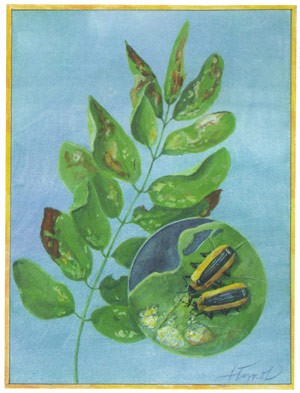
In leafminers, the larval stage typically is spent in a leaf’s interior between the upper and lower epidermal layers, feeding on the spongy and palisade parenchyma cells. Though this environment may seem to be a severely restricted, miserable place to spend your days, insects from several different orders have chosen to trade their freedom, as it were, for the protection that leaf surfaces provide. There are leafminer species that feed within almost every kind of leaf, even on plants with milky sap or that are poisonous to other animals. Most miners are moth species, but flies, sawflies, and even a few beetles have also chosen this lifestyle.
The success of one of these beetles, called the locust leafminer, is apparent in late summer along many highways, a habitat often dominated by large, clonal clumps of black locust. By August, black locusts over a large part of the Northeast look blighted, and this is usually the result of feeding by what must be many billions of locust leafminers. A few other insect species may be adding their mandibles to the devastation, but locust leafminers are probably getting the lion’s share of locust leaf innards.
The native range of black locust is small: the southern Appalachians, lower Ohio valley, and the Ozarks. Beginning in Colonial times, however, it was planted throughout the eastern U.S. (and less extensively in the western states and in Europe) and has spread on its own from these plantings. A nitrogen-fixer in the legume family, black locust grows well on disturbed and degraded sites, such as roadsides. Its hard, rot-resistant wood was a first choice for fence posts and many other farm uses.
Leafminer mines may be of the linear, digitate, or blotch type, or any combination of those shapes, and these insects are said to “write their signatures in the leaves,” which helps in identifying some of them in the larval stage. And help is indeed needed, for many of the larvae are similarly shaped by the constraints of their living quarters: small, flattened, legless or nearly so, and with minimal eyes or antennae. Some have wedge-shaped heads, useful in separating the upper and lower leaf surfaces as the larva feeds its way around inside a leaf.
After spending the winter in leaf litter, the handsome, ¼-inch-long, black-and-orange adult beetles feed on newly emerging locust leaves. After mating, the female lays groups of three to five eggs on the underside of a leaflet. The hatchlings burrow to the interior of a leaf and feed communally for several days. Then each makes its way to a new leaflet. This particular miner tends to begin near the tip of a locust leaflet, and the blotch created by its feeding spreads downward. Locust leaflets are small, and each larva may consume several of them.
When it has grown to just over a quarter-inch in length, the larva pupates within the leaf. Upon emerging, usually in August, adults chew out of their confined quarters and resume their assault on the foliage, this time from the outside, skeletonizing what live leaves remain.
The locust leafminer did not seem to be a serious pest in northern New England until 30 or so years ago, though its “ravages” had been reported in Massachusetts as early as 1835. Perhaps the increased use of black locust in the 1950s and 60s by the Soil Conservation Service for soil stabilization helped the insect follow the northward march of its host.
For the last several years, black locusts have been so “ravaged” in our area that there’s not a green leaf to be seen by late summer. You can’t help but wonder how they survive, but, spring after spring, bright new leaflets emerge, almost as though nothing had happened to them the year before. Perhaps their ability to fix nitrogen is helpful. And although the leafminers begin work fairly early in the season, defoliation is not usually finished until fairly late in the summer, giving the thrifty locust time to top up its carbohydrate reserves.
The life of a tree is complex, intimately intertwined with the lives of insects and diseases and continually influenced by its growing conditions. More often than not, it is impossible to identify a single cause of a serious outbreak. Sometimes prolonged outbreaks such as this subside – again for unknown reasons. Let’s hope this is the case with locust leafminers. They have their place in the world, but not on every locust leaf for miles around.

